1.1: Learning How to Speak Publicly
1.1.1: Learning How to Speak Publicly
There are a variety of traditional and nontraditional avenues available for you to learn about public speaking.
Learning Objective
Find ways to improve your public speaking skills.
Key Points
- You can learn about public speaking through organized learning opportunities, such as classes and organizations like Toastmasters International.
- If you prefer to learn at your own pace, you can read books about public speaking. Many are available at little or no cost.
- If you prefer one-on-one guided learning, consider hiring a public speaking coach.
- For an even more nontraditional approach, the Internet is rife with free materials, guides and videos to help you learn more about speaking in public.
Key Term
- Toastmasters International
-
Toastmasters International (TI) is a nonprofit educational organization with clubs worldwide. They help members improve their communication, public speaking, and leadership skills. Through its thousands of member clubs, TI offers a program of communication and leadership projects designed to help people learn the arts of speaking, listening, and thinking.
When you see politicians and other speakers addressing a crowd with ease and eloquence, it seems as though they were born to speak in front of people. The truth is, public speaking is an art learned over time, and with practice, there are many ways to learn it.
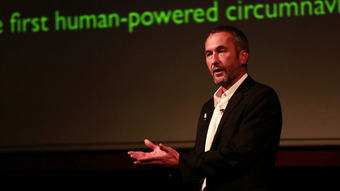
Public Speaking
Adventurer Jason Lewis speaking publicly at the Royal Geographical Society in London
If you’re using this online textbook to support material you’re learning in a class, you’re already engaged in one of the basic ways of learning to speak in public. Classroom learning is one of the most common ways for students to learn about communications and public speaking. With guidance from a dedicated teacher, along with accompanying texts, supporting materials, and in-class practice, your basic public speaking course will prepare you to make your first big speech.
Take a Class
If you’re not taking a class, you might find structured learning opportunities through clubs and nonprofit organizations such as Toastmasters International. Toastmasters focuses on the art of public speaking, communication, and leadership skills. They offer a variety of programs, competitions, and conferences to help people like you become better public speakers.
Hit the Books
If you don’t have time for a class and would like to learn more about public speaking at your own pace, consider visiting your local library to find print or digital books on public speaking. Many are tailored to specific types of public speaking (such as political or business) and are often available at little or no cost.
Learning Outside the Box
If reading a book or attending a class still seems too formal, there are plenty of other ways to learn about speaking in public. You might benefit most from personalized, one-on-one attention and directed learning. In this case, consider hiring a public-speaking coach. These individuals are often certified to give personal training and attention to individual clients. Conduct research to learn about their experience and training, and ask to speak with some of their other clients. You can also “hire” a virtual coach by looking for public speaking skill-training videos online, using sites such as YouTube or eHow. Videos about public speaking can give you all the benefits of personalized coaching but from the comfort of your own living room. When looking for videos on public speaking, try to learn what you can about the people producing these videos: What experience and credentials do they have? Are they created by a single person, or the work of a professional company or educational institution?
The benefit of all these ways of learning about public speaking is they all complement one another. If you’re feeling deficient in one skill set after using a certain learning method, turn to another method to bolster your knowledge. Keep in mind, practice is the best way to improve your public speaking ability. Take every opportunity you can to speak in front of an audience to boost your confidence, as well as your skill.
Regardless of the method you choose to learn about public speaking, go in with an open mind and an eagerness to learn. This will allow you to get the most from your curriculum, no matter how it’s constructed or delivered.
1.1.2: Best Practices in Public Speaking
Your public speaking can be improved through various practices both before and during the speech.
Learning Objective
Discuss the high-level best practices for giving a speech
Key Points
-
Construct a well-organized speech with an engaging
topic and a clear theme in order to hold your audience’s attention. -
Build confidence beforehand through rehearsal, and
use techniques such as meditation to reduce anxiety. -
When delivering the speech, keep in mind how your
vocal delivery and visual appearance can enhance your message. -
Consider the background of the audience before the
speech, and the reactions of the audience during the speech.
Key Terms
- topic
-
Subject; theme; a category or general area of interest
- audience
-
One or more people within hearing range of some message; for example, a group of people listening to a performance, speech etc. ; the crowd attending a stage performance.
Writing
the Speech
Good public speaking begins with the content of the
speech itself. The first thing you should consider is the topic, or subject, of
the speech. Choosing a topic that is relevant to your audience’s interests will
help you keep them engaged. Once a topic is chosen, narrowing down the focus of
the topic will allow you to cover more detailed information, and your audience
should find the speech easier to follow as a result. When writing the speech,
keep the purpose of your words in mind. Do you want to inform your audience of
something, or do you want to persuade them to your side of an argument?
Creating a well-organized speech that introduces a topic, emphasizes a few main
points, and leads to a conclusion that sums up a central thesis, will make your
job easier when it comes time to speak.
Preparing
Beforehand
Sometimes the idea of speaking publically can be
overwhelming. Practicing your speech and mentally preparing yourself beforehand
can lessen anxiety and build confidence for the moment you’re in front of a
crowd. Rehearsing the speech out loud after writing it can assist you in
nailing down good timing and refining your intonation. This will also help you
memorize what you’ve written, thereby allowing you more freedom with your delivery.
If you feel anxious at the thought of public speaking, trying relaxation
exercises such as deep breathing or even meditation may help you clear out
negative thoughts. Envisioning the speech going well can also lead you to a
feeling of empowerment. Whatever strategy you choose, planning days or even
weeks in advance will make the experience of public speaking more manageable.
Delivering
the Speech
Even if you’re confident in the quality of your
speech beforehand, the actual process of speaking in front of an audience
provides many opportunities to enhance your message. As the focus of attention,
you have the ability to use both vocal and visual elements to your advantage. Effective
vocal delivery involves changing elements such as pitch, volume, and speaking
rate in order to emphasize parts of your speech that are integral to its theme.
In terms of visual elements, maintaining eye contact and keeping an open
posture can help you build a relationship with the audience. On the other hand,
inappropriate dress and unnecessary gestures can distract your audience.

Audience
Public speakers should keep their audience in mind when preparing and delivering a speech.
Thinking
of the Audience
The audience is the target of your speech, and effectively
communicating your theme to them is the goal of good public speaking. As such,
you should always keep the audience in mind both before and during your time on
stage. Knowing details about your audience in advance, such as age, religion,
and educational background, can help you tailor your message to make it more
relevant to them. While talking, pay attention to both verbal and non-verbal
feedback of crowd members to determine if they are engaged or distracted. If
you sense they are distracted, changing the pace of the speech with an inquiry
or story can reengage them.
1.2: History of Public Speaking
1.2.1: History of Public Speaking
Our current knowledge and practice of public speaking draws upon the Western thought from Greece and Rome.
Learning Objective
Identify key figures of public speaking through the ages
Key Points
- The formal study of public speaking began approximately 2,500 years ago in Greece and Rome to train citizens to participate in society.
- Aristotle (384-322 BCE), the most famous Greek Scholar, defined rhetoric as the “faculty of discovering the possible means of persuasion in reference to any subject whatever.” He divided the “means of persuasion” into three parts–logical reason (logos), human character (ethos), and emotional.
- Cicero (106-43 BCE), one of the most significant rhetoricians of all time, developed the five canons of rhetoric, a five-step process for developing a persuasive speech that we still use to teach public speaking today.
- Quintilian (c. 35-95 CE) argued that public speaking was inherently moral. He stated that the ideal orator is “a good man speaking well”.
- American Revolution–The rhetorical studies of ancient Greece and Rome were resurrected as speakers and teachers looked to Cicero and others to inspire defense of the new republic. John Quincy Adams of Harvard advocated for the democratic advancement of the art of rhetoric.
- Throughout the 20th century, rhetoric developed as a concentrated field of study with the establishment of public speaking courses in high schools and universities. The courses in speaking apply fundamental Greek theories (such as the modes of persuasion: ethos, pathos, and logos).
Key Terms
- sophist
-
One of a class of teachers of rhetoric, philosophy, and politics in ancient Greece, especially one who used fallacious but plausible reasoning.
- orator
-
A skilled and eloquent public speaker.
- rhetoric
-
The art of using language, especially public speaking, as a means to persuade.
History of Public Speaking
Our current knowledge and practice of public speaking draws upon ancient Greek, Roman, and Western thought.
The Classical Period (500 BCE – 400 BCE)
The ancient Greeks highly valued public political participation, where public speaking was a crucial tool. We will begin an overview of four Ancient Greek philosophers, also known as the “fantastic four”Aspasia of Miletus, Socrates, Plato, and Aristotle.
Aspasia of Miletus (469 BCE), the “mother of rhetoric,” is believed to have taught rhetoric to Socrates. During this period Pericles, the Athenian ruler and Aspasia’s partner, treated Aspasia as an equal and allowed her the opportunity to engage in dialogue with the important and educated men of society.
Socrates (469-399 BCE) greatly influenced the direction of the Classical Period. Most of what we know about Socrates comes from the writings of his student Plato.
Plato (429-347 BCE) wrote about rhetoric in the form of dialogues with Socrates as the main character. Plato defined the scope of rhetoric according to his negative opinions of the art. He criticized the Sophists for using rhetoric as a means of deceit instead of discovering truth.
Aristotle (384-322 BCE) is the most famous Greek Scholar. Aristotle studied in Plato’s Academy where he later taught public speaking until Plato’s death in 347 BCE. During this time, he opened his own school of politics, science, philosophy, and rhetoric.

Aristotle
This statue resides at Aristotle University of Thessaloniki, Greece.
Aristotle defined rhetoric as the “faculty of discovering the possible means of persuasion in reference to any subject whatever.” Aristotle divided the “means of persuasion” into three parts, or three artistic proofs, necessary to persuade others: logical reason (logos), human character (ethos), and emotional appeal (pathos).
Sophist (400s BCE): The Classical Period flourished for nearly a millennium in and around Greece as democracy gained prominence. Citizens learned public speaking from early teachers known as Sophists. Sophists were self-appointed professors of how to succeed in the civic life of the Greek states.
The Romans: Cicero and Quintilian
Cicero (106-43 BCE) is considered one of the most significant rhetoricians of all time. His works include the early and very influential De Inventione (On Invention), often read alongside the Ad Herennium as the two basic texts of rhetorical theory (throughout the Middle Ages and into the Renaissance); De Oratore (a fuller statement of rhetorical principles in dialogue form); and Topics (a rhetorical treatment of common topics, highly influential through the Renaissance). Cicero is most famous in the field of public speaking for creating the five canons of rhetoric, a five-step process for developing a persuasive speech that we still use to teach public speaking today.
Quintilian (c. 35-95 CE) extended this line of thinking and argued that public speaking was inherently moral. He stated that the ideal orator is “a good man speaking well. “
The Medieval Period (400 CE – 1400 CE)
In contrast to the Classical Period, which saw tremendous growth and innovation in the study of communication, the Medieval Period might be considered the dark ages of academic study in public speaking. The church felt threatened by secular rhetorical works they considered full of pagan thought. The Church did, however, focus on persuasion and developing public presentation to improve preaching.
St. Augustine (354 CE-430 CE), a Christian clergyman and renowned rhetorician, argued for the continued development of ideas that had originated during the Classical Period. He thought that the study of persuasion, in particular, was a worthwhile pursuit for the church.
The Renaissance (1400-1600 CE)
Powered by a new intellectual movement during this period, secular institutions and governments started to compete with the church for personal allegiances. Ideas surrounding issues of style in speaking situations received significant attention during the Renaissance period.
Petrus Ramus (1515-1572) paid great attention to the idea of style by actually grouping style and delivery of the five canons together. Ramus also argued that invention and arrangement did not fit the canon and should be the focus of logic, not rhetoric. Ramus challenged much of what early scholars thought of truth, ethics, and morals as they applied to communication.
Francis Bacon (1561-1626), a contemporary of Shakespeare, believed that the journey to truth was paramount to the study and performance of communication. According to Bacon, reason and morality required speakers to have a high degree of accountability, making it an essential element in oration.
The Enlightenment (1600 – 1800 CE)
Neoclassicism revived the classical approach to rhetoric by adapting and applying it to contemporary situations.
George Campbell (1719-1796), a Scottish minister and educator, tried to create convincing arguments using scientific and moral reasoning by seeking to understand how people used speech to persuade others.
Finally, the elocutionary approach (mid 1700’s to mid-1800’s) concentrated on delivery and style by providing strict rules for a speaker’s bodily actions such as gestures, facial expressions, tone, and pronunciation.
Overall, the Enlightenment Period served as a bridge between the past and the present. Political rhetoric also underwent renewal in the wake of the U.S. and French revolutions. The rhetorical studies of ancient Greece and Rome were resurrected in the studies of the era as speakers and teachers looked to Cicero and others to inspire defense of the new republic. Leading rhetorical theorists included John Quincy Adams, who advocated for the democratic advancement of the art of rhetoric.
New School — 1900s and 2000s Through Today
Throughout the 20th century, rhetoric developed as a concentrated field of study with the establishment of rhetorical courses in high schools and universities. Courses such as public speaking and speech analysis apply fundamental Greek theories, as well as trace rhetorical development throughout the course of history.
The 1960’s and 70’s saw renewed emphasis and focus on the works of those from the Classical Period. Thus, the 60’s and 70’s worked to bridge together the old and new school of communication study for the first time. Communication departments had professors who studied and taught classical rhetoric, contemporary rhetoric, along with empirical and qualitative social science.
1.3: What You Can Accomplish with Public Speaking
1.3.1: Summary of the Benefits of Public Speaking
Public speaking can enrich the speaker’s personal and professional life, and also provide opportunities to influence the outside world.
Learning Objective
List the benefits of developing public speaking skills
Key Points
- Public speaking can be a great self-esteem booster.
- Public speaking engagements are great places to meet new social and professional contacts.
- If you would like to change the world, remember–public speaking is an effective platform for spreading revolutionary ideas.
Key Terms
- critical thinking
-
he application of logical principles, rigorous standards of evidence, and careful reasoning to the analysis and discussion of claims, beliefs, and issues
- publicity
-
Advertising or other activities designed to rouse public interest in something.
- networking
-
the act of meeting new people in a business or social context.
Summary of the Benefits of Public Speaking
The previous segments in this chapter explained how public speaking can enrich personal life, professional life, and the outside world. Still not convinced? If you worry that public speaking has nothing to offer you, or simply isn’t worth the stress, then check out this brief review of the benefits of public speaking:
Personal Satisfaction
OVERCOME FEARS
Many people have a phobia of public speaking. Jerry Seinfeld put it this way: “According to most studies, people’s number one fear is public speaking. Number two is death. Death is number two. Does that sound right? This means to the average person, if you go to a funeral, you’re better off in the casket than doing the eulogy. “Even though public speaking can be scary, it is possible to succeed in spite of these fears–with preparation and practice.
BOOST SELF-ESTEEM
Public speaking is quite the self-esteem booster. Overcoming the fears and insecurities that accompany public speaking is empowering. Furthermore, connecting with audiences can be a great reminder that you have valuable insights and opinions to share with the world.
SHARE YOUR VIEWS WITH OTHERS
It can be very satisfying to share something that matters to you with people outside your usual social circle.
Critical Thinking
IMPROVE CRITICAL THINKING SKILLS
The process of writing a speech will exercise and strengthen your critical thinking skills, from the research to the actual speech-drafting.
ANALYZE COMMUNICATION HABITS
Preparing a speech will force you to reevaluate the way you communicate and re-examine your speaking habits.
Personal Development
IMPROVE COMMUNICATION SKILLS
When you write a speech, you have to think carefully about the best organizational framework, persuasive strategy, and language to communicate your message to the audience. This type of thinking can help you improve your communication skills in other areas of your life.
MAKE NEW SOCIAL CONNECTIONS
Public speaking engagements are great places to meet other people who share your interests.
Career Advancement
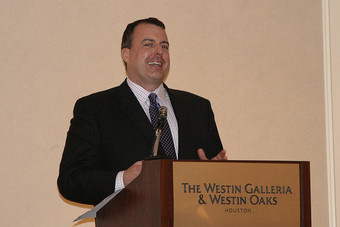
PRSA Houston Speech
Bryant A. Hilton, a public relations representative for Dell, giving a speech entitled “Going Green: Dell’s Journey to Sustainability.”
IMPRESS YOUR BOSS
Success in public speaking indicates creativity, critical thinking skills, leadership abilities, poise, and professionalism–qualities which are very valuable for the job market.
GAIN PUBLICITY
Public speaking is a great way to bring your message to a wider audience.
EXPAND YOUR PROFESSIONAL NETWORK
Public speaking can bring like-minded professionals together to share ideas. These engagements are great networking opportunities!
PERSONALIZE YOUR PROFESSIONAL REPUTATION
If you establish a good reputation as a public speaker, your public persona will set you apart from the sea of faceless resumes and cover letters.
Influence the World Around You
FIND THE RIGHT WORDS TO INSPIRE CHANGE
Public speaking has a long history as a catalyst for nonviolent activism and political change. It is a powerful way to unite people under a common cause and motivate them to take action.
1.3.2: Personal Benefits of Public Speaking
Public speaking has great personal benefits, such as building self-esteem, honing critical thinking skills, and presenting networking opportunities.
Learning Objective
List the rewards of public speaking
Key Points
- Public speaking can be intimidating. It is actually a common phobia. Overcoming this fear can be a satisfying personal victory.
- Public speaking is a great way to further personal development on many levels, since improving communication skills is helpful in every area of life: personal and professional.
- Public speaking engagements are great places to meet new people and build your social and professional networks.
Key Term
- critical thinking
-
The application of logical principles, rigorous standards of evidence, and careful reasoning to the analysis and discussion of claims, beliefs, and issues.
Personal Benefits: Satisfaction, Development, Critical Thinking, Social Connections
Personal Satisfaction
Public speaking is a very common phobia, right up there with spiders and killer clowns. Many people would prefer to do almost anything—even clean the bathroom—instead of standing up and talking in front a crowd of people. Delivering a speech can feel intimidating and risky. Fears and insecurities tend to multiply as the speech draws closer: “What if I freeze up?” “What if I forget my speech?” “What if people get bored and walk out?” “What if the audience tears me apart during the Q&A?”

Common Phobias
Many people have phobias. Just like some people are scared of spiders, others are afraid of public speaking.
If you’re thinking, “Why would I want to do something so stressful?” then remember: no risk, no reward! These fears don’t have to be crippling—practice and preparation can build confidence leading up to a speech. Overcoming these fears is an empowering experience. Public speaking is a great way to show yourself that, with practice, you can do the things that scare you the most. What starts out as a nightmare can turn into a great self-esteem boost.
Once the nervous jitters are under control, you may discover that public speaking is actually very rewarding. It can be satisfying to explain your views to a room full of people. Having the opportunity to share a message you care about is actually pretty special. If you think about it that way, public speaking can be satisfying on a personal level.
Critical Thinking
Public speaking is also a great way to build critical thinking skills. Writing a speech requires a great deal of careful thought, from the audience analysis to the outline to the conclusion. It’s not enough to have a message—you also need to figure out how to tailor the message to fit the needs of your audience. How can you make your points relevant to your listeners? How can you help the audience understand your views? Thinking in this way is a great exercise for improving general communication skills. If you start thinking critically about your speaking style, you may find ways to improve your general communication style at home and at work.
Personal Development
Communication skills are crucial for personal and professional success. Preparing a speech forces speakers to take a step back and think critically about effective ways to communicate. In day-to-day life, it is easy to fall back on communication habits we formed many years ago. If communication is the backbone of the important relationships in your life, isn’t it worth taking some time to work on it? Improving your communication skills can make life more fulfilling on many levels.
Social Connections
Are you looking for new ways to network and make social connections? Try public speaking. Giving a speech is like starting a conversation with a room full of people—and you can continue that conversation as soon as you step down from the podium. You and your audience share an interest in the topic of your speech, so you already have something to talk about! If the schedule allows, try to mingle with the audience after your speech, answering questions and seeking fresh perspectives on your topic. Give audience members the option of getting in touch with you at a later date by listing contact information on handouts or slides. If you have a website, direct audience members to find more information there. If you are part of a speaking lineup, reach out to your fellow presenters. Congratulate them or, if you miss a talk, ask how it went. There are lots of opportunities for networking in the realm of public speaking, so plan ahead and make use of them.
1.3.3: Career Benefits: Advancement
Public speaking is a great tool for career advancement because it provides opportunities to impress the boss, seek publicity, and network.
Learning Objective
Use public speaking as a tool for career advancement
Key Points
- Public speaking is a great way to showcase your talents, skills, and abilities.
- For professionals who want to build a personal brand, increase publicity, or earn a reputation as an expert, public speaking is a great way to further those ambitions.
- Public speaking engagements are great networking opportunities.
Key Term
- networking
-
the act of meeting new people in a business or social context.
Career Benefits: Advancement
Public speaking can be a great way to advance your career. No matter what your goals are, showing your boss that you deserve a raise, advertising your “personal brand,” or finding new career opportunities, public speaking can help you achieve them.
Impressing the Boss
Success in public speaking is a good indicator of valuable professional skills. Composing an effective speech demonstrates creativity and critical thinking. Holding an audience’s attention demonstrates a talent for leadership. Maintaining confidence and poise during a speech and Q&A session demonstrates professionalism under pressure. If you’re trying to impress your boss, public speaking can be a great showcase for your professional abilities.
Self-Promotion
If you’re looking for publicity, speaking engagements are a great place to start. Look for opportunities to discuss your area of knowledge, and present yourself as an expert. One caveat: you still need to do a thorough audience analysis. If you don’t connect your personal story to bigger issues that affect the audience, you will seem self-centered and irrelevant. If you spout opinions without establishing credibility, you may come across as a charlatan. Even if your goal is self-promotion, remember: the world doesn’t revolve around you, and neither should your speech. You want good publicity, not bad publicity!
Networking

Meeting New People
In many business cultures, networking involves meeting new people. A handshake is a common gesture.
Public speaking is a great way to connect with people who share your interests and goals. You can get more mileage out of speaking engagements if you initiate conversations with other speakers and audience members. Find out more about their interests, and take those interests into consideration when you write your next speech.
In terms of professional networking, public speaking can help you gain an edge over the competition. A speech will show more of your personality than a resume or cover letter. You can control the content and tone of a speech more easily than you can dictate the content of a job interview. The primary elements of the typical job application–the resume, cover letter, and interview–are tough to ace, since rigid formatting makes it difficult to stand out from the crowd. When you have public speaking opportunities in a professional context, take advantage of them! Try to be memorable, make connections, and follow up afterward. If your professional connections know you as a speaker, you will be more than just another faceless resume and cover letter.
1.3.4: External Benefits: Influence the World Around You
Public speaking skills can be used to influence the world through public leadership and in personal day-to-day applications.
Learning Objective
Give examples of ways public speaking can lead to influence
Key Points
- There is a strong correlation between communication skills and leadership. Speakers can use knowledge of persuasion to motivate others to take collective action to achieve desired goals.
- Modern communication technology allows speakers to share their message and influence audiences any place in the world, for the cost of an internet connection and camera phone.
- Experienced speakers can use their skills to accomplish simple goals in daily life with new self-confidence.
- Trained speakers should ask, “How will I use my skills to influence the world around me? ” and other relevant questions.
Key Terms
- orator
-
A skilled and eloquent public speaker.
- leadership
-
A process of social influence in which one person can enlist the aid and support of others in the accomplishment of a common task.
Example
- Can words really change the world? When Martin Luther King, Jr. stood on the steps of the Lincoln Memorial and delivered his famous “I Have a Dream” speech, he put his faith in the power of public speaking. King’s faith was justified; that speech is credited with paving the way for the 1964 Civil Rights Act, a bill that took important steps toward making his dream a reality. King remains one of the most revered orators of all time, and a stellar role model for those who believe words can change the world.
External Benefits: Influence the World Around You
Public speaking skills allow people to to influence the world through public leadership in society, including roles in commercial organizations, the volunteer sector, groups, and clubs. They can also enhance one’s personal development and self-confidence.
Public Leadership as Influence
Public speakers have the opportunity to influence others; they can use their knowledge of persuasion to motivate others to take collective action to achieve desired goals. There is a strong correlation between leadership and communication skills. Leadership has been described as “a process of social influence in which one person can enlist the aid and support of others in the accomplishment of a common task. ” Public speaking skills can be used to influence multiple people simultaneously, such as in a meeting or when addressing a large group. Speaking skills can help when setting and agreeing to a motivating vision or future for a group or organization to ensure unity of purpose; creating positive peer pressure towards shared, high performance standards and an atmosphere of trust and team spirit; and driving successful collective action and results.
Martin Luther King, Jr., Winston Churchill, and Nelson Mendela are notable examples of effective orators who used oratory to have a significant impact on society. The influence of the great leaders may have been initially limited to moving an audience in person with written copies of their speeches distributed. With the invention of radio and television, listeners who could not attend in person were still influenced by the words of the speaker.
Global Leadership as Influence
Today, the reach of technology is pervasive and global. In the past, influencing others involved speaking directly to an audience face-to-face or having expensive equipment for broadcasting. Today, modern communication technology coupled with the internet means that speakers can share messages and thoughts with audiences anyplace in the world for the cost of an internet connection and a camera, or simply a smart phone recorder.
How Influence Works in Daily Life
Public speaking skills are not reserved for global leaders; anyone can use the same skills in his or her daily life to speak with confidence. Aristotle defined rhetoric as the “faculty of discovering the possible means of persuasion in reference to any subject whatever. “
For example, imagine someone who wants to persuade his or her parents for money. Chances are that this person will work through strategies for persuading them why he or she needs the money and why the parents should provide it. He or she will reflect on what has and has not worked in the past, including previous successful and unsuccessful strategies. From this analysis, he or she constructs a message that fits the occasion and audience.
Now, imagine that the same person wants to persuade his or her roommate to go out to get Mexican food for dinner. He or she is not going to use the same message or approach that he or she used with the parents. The same logic exists in public speaking situations. Aristotle highlighted the importance of finding the appropriate message and strategy for the audience and occasion in order to persuade.
By training in public speaking and actually speaking in front of an audience, one develops a sense of self-confidence. Public speakers learn to overcome fear of failure and lack of confidence in order to deliver a message to an audience. They learn to think about ideas, evaluate their truthfulness, and then organize them into a message to share with others.
The flip side of public speaking is listening; people can learn how to influence by learning how to listen. Trained speakers know how to recognize sound logic, reasoning, and ethical appeals. A critical listener is less likely to be persuaded by unsound logic and fallacies or to take action that is not in his or her best interest.
How Everyone Can Influence the World
The world is still full of injustice, ranging from major issues such as poverty to minor issues such as people who cut in line. Every prospective speaker should ask, “Is there a particular cause that has personal significance for me? If I could change something about the world, what would I choose? If studying the art of public speaking will give me the tools to influence the world around me, how will I use them? “
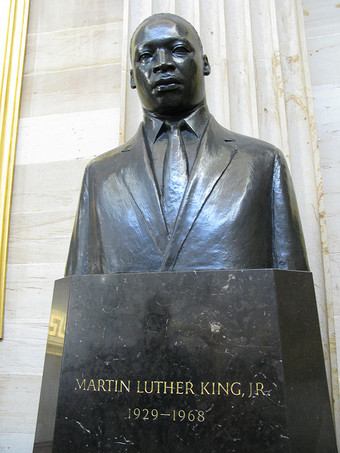
Bust of Martin Luther King, Jr.
Martin Luther King, Jr. used his ability to speak to influence and lead a nation to action.
1.3.5: Differences Between Public Speaking and Conversation
While public speaking and conversation share many similarities, they are in fact two very different forms of communication.
Learning Objective
Differentiate between public speaking and conversation
Key Points
- Public speaking is the process of speaking to a group of people in a structured, deliberate manner intended to inform, influence, or entertain the listeners.
- Conversation is a form of interactive, spontaneous communication between two or more people who are following rules of etiquette.
- There are three key differences that set public speaking apart from conversation: organizational structure, use of formalized language, and method of delivery.
- Speeches involve thoughts that are logically organized and structured, whereas conversations may wander around subjects.
- Speeches use formalized language, while conversation may use slang, profanity, or poor grammar.
- Speeches are often delivered in deliberate, intentional settings and contexts, whereas conversations may arise spontaneously.
Key Term
- conversation
-
the expression and exchange of individual ideas through talking with other people; also, an instance of such talking
Differences with Conversation
It may seem rather simple: isn’t public speaking just a form of conversation with an audience? At the most basic level, that might seem true. But under closer inspection, public speaking and conversation are, in fact, two very different things.

Differences in Conversation
While public speaking involves imparting a message to others, there are key differences between public speaking and casual conversation.
Public speaking is defined as “the process of speaking to a group of people in a structured, deliberate manner intended to inform, influence, or entertain the listeners.” Conversation, on the other hand, “is a form of interactive, spontaneous communication between two or more people who are following rules of etiquette.”
You may already notice the similarities: both conversation and public speaking involve speakers and audiences, as well as messages exchanged between the two parties. Depending on to whom you’re speaking, you’ll adjust your message based on both your audience and the context of your speech or conversation. And of course, a good conversation and a good speech both share elements of compelling and engaging storytelling.
But, for the most part, that’s where the similarities between conversation and public speaking end. There are three key differences that set public speaking apart from conversation: organizational structure, use of formalized language, and method of delivery.
Organizational Structure
Speeches and public addresses are far more organized than everyday conversation. A public speaker organizes his or her thoughts in a speech by using three basic structural elements: an introduction, a body, and a conclusion. Conversations can wander and meander without ever coming to a point. Speeches are deliberately structured and organized, whereas conversations are not.
Use of Formalized Language
When you sit down and have a conversation with a close friend, either face-to-face or via text message or chat, you might find that your language and tone are far more casual than if you were to sit down and have a conversation with, say, your doctor. Public speaking formalizes language that much more. When speeches are designed to “inform, influence, or entertain,” they require a certain formality of speaking compared to a casual conversation between friends. Slang, profanity, and poor grammar might be accepted between friends but are definitely not appropriate for any kind of public address or speech.
Method of Delivery
You hear the phrase “strike up a conversation” more than you hear “strike up a speech” because conversations are far more spontaneous than public speeches. And don’t let extemporaneous speaking fool you: extemporaneous speeches merely involve speaking about a subject with no written notes and are not to be considered truly spontaneous. Conversations can spring up anywhere. Public speaking is often organized into events and venues with a set time and location. Public speeches may also fall within certain time constraints, whereas conversations can be as brief or as long as those involved are willing to participate.
1.4: Elements of Speech Communication
1.4.1: Speaker
The speaker is one of the key elements of the basic speech communication model.
Learning Objective
Define the speaker in the basic speech communication model
Key Points
- Speech communication, in its simplest form, consists of a sender, a message and a recipient. The speaker and sender are synonymous.
- The speaker is the initiator of communication.
- Effective speakers are those who can most clearly delivery their message to their recipients.
Key Term
- sender
-
someone who encodes and sends a message to a receiver through a particular channel; the initiator of communication.
Elements of Speech Communication: The Speaker
— Example image of a speaker

The Speaker
President Barack Obama giving a speech in Accra, Ghana on July 11, 2009.
The communication cycle offers a model for communication. In its simplest form, the cycle consists of a sender, a message, and a recipient. Other models include the channel, which is the vehicle in which your message travels. For the purposes of speech communication, the speaker is you!
The speaker is perhaps the second most important factor in the speech communication model, second only to the message (your speech) itself. Let’s take a step back and look at a very specific definition of the message speaker, or sender:
A sender is someone who encodes and sends a message to a receiver through a particular channel. The sender is the initiator of communication.
When you think about how you craft your speech, you’re actually encoding your message. This doesn’t mean that your speech is laced with cryptic clues for your audience to determine the meaning and purpose, rather, it gives you a way to think about your speech in a new light. Your message’s recipient, the audience, will have to decode your message. With their brainpower, experience and intellect, they need to make sense of the very message you’re trying to deliver. This is why it’s so valuable to understand the importance of your role as speaker, as the initiator of communication in the delivery of your message.
When you are able to successfully communicate your message, that is, when the audience can decode your message, then you have become a successful communicator.
1.4.2: Message
The message is the most important and instrinsic element of all speech communication models.
Learning Objective
Define the message of the basic speech communication model
Key Points
- With regard to public speaking, your speech is your message.
- Your audience, the receiver, may send you a message in response to your message in the form of feedback.
- Messages consist of both verbal and non-verbal elements. Your words and how you deliver them equally make up the balance of your message.
Key Term
- message
-
A communication, or what is communicated; any concept or information conveyed.
Elements of Speech Communication: The Message
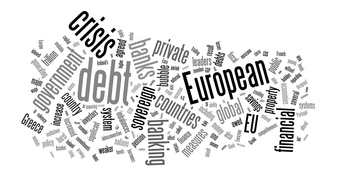
The Message
What is the message that you’re trying to get across to your audience?
No matter which model of communication you study, every model includes the most important element of all: the message. You can’t have communication without a message. The word “message” actually comes from the Latin mittere, “to send. ” The message is fundamental to communication.
With regard to public speaking and speech communication, your speech is your message. But you may have other intentions for your speech as well: the message behind the message. Perhaps you have a singular goal, point or emotion you want your audience to feel and understand. Every single word that you use to craft your speech then, works to achieve that singular goal, point or emotion.
As the sender, the speech writer and speech giver, you may also be getting messages back from your receivers: your audience. This is what’s known as feedback, when the receiver sends a message of response back to the sender. In this way, messaging becomes a dynamic conversation of feedback as the sender sends his or her message to his or her audience, receives feedback from the audience, and then adjusts the message accordingly based on said feedback.
Messages can be sent both verbally and non-verbally. You can say one thing with your words, but depending on how you say it and the non-verbal cues such as posture and eye contact, you may send an entirely different message to your audience. That said, it’s important to consider all aspects of your overall message, from verbal to non-verbal to the meaning and message behind the message, when crafting your speech.
1.4.3: Channel
The channel is the method (auditory and visual) that is used to transmit the message to the receiver.
Learning Objective
Give examples of auditory and visual channels used in public speaking
Key Points
- In a face-to-face setting, the channel will be primarily audio and visual; in a speaking situation with remote audience via videoconferencing, the channel will be computer mediated audio and visual.
- When the speaker and the audience are in the same room at the same time, the channels of communication are synchronous.
- When listeners receive the speech at some time after the speech was delivered, the channels are asynchronous (that is, in delayed time).
Key Terms
- mediated
-
Acting or brought about through an intervening agency.
- channel
-
The method a sender uses to send a message to a receiver. The most common channels humans use are audtiory and visual.
- co-located
-
To locate or be located at the same site, for two things or groups at same space.
Elements of Speech Communication: The Channel
A basic speech communication model includes a sender (that is, a speaker), a message, a receiver (that is, an audience), and a channel. Claude Shannon, who developed one of the earlier communication models, defined the channel as the medium used to transmit the signal from the transmitter to the receiver. In a face-to-face, in-person speaking situation, the channel will be primarily audio using sound and visual using light waves; in a speaking situation with a remote audience via videoconferencing, the channel will be computer mediated audio and visual.
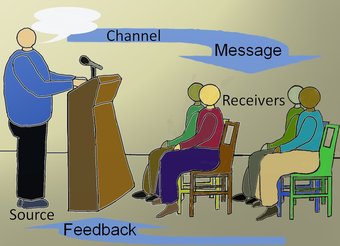
Communication Channel Model
The speaker uses the channel, or speech, to transmit the message to the audience.
Face-to-Face, Co-Located Audience Channel
When speaking to an audience in person, a speaker uses both verbal and non-verbal methods to communicate the message. The sounds that a speaker makes are interpreted as words. The sounds are transmitted through an audio (or auditory) channel as sound waves and are received by the listeners in the audience. Speakers also use their hands to make gestures, change their facial expressions, and project images or words on a screen. These cues are received by the listeners through the visual part of the channel: their sense of sight. When the speaker and the audience are in the same room at the same time, the channels of communication are synchronous, in real time.
Computer Mediated Communication (CMC) Channel
Speakers also use communication channels that are mediated, meaning there is something between the speaker and the receivers. In some cases, the auditory and visual signal is mediated by a computer to convert what the speaker says and does into a digital signal that is transmitted to remote audiences. Computer Mediated Communication (CMC) is able to overcome physical and social limitations of other forms of communication, and therefore allow the interaction of people who are not physically sharing the same space. Computer mediated digital channels may be synchronous, when remote audiences are listening to the speech via computer conferencing or streaming audio and video at the same time the speech is being delivered. The channel might also be asynchronous, when audiences listen to the speech at some time after the speech was delivered, perhaps via a website like youtube.com or vimeo.com. The message delivered through CMC channels could be only audio, but is likely to involve both audio and video, which uses the auditory and visual senses of the humans to decode the digital signals and process the message.

Shannon Weaver Communication Model
The channel in the middle links the speaker with the receiver of the message.
1.4.4: Audience
Your audience represents one very important third in the basic model of communication.
Learning Objective
Analyze your audience based on demographics
Key Points
- “Who is my audience? ” is the first question you should ask yourself before you begin crafting your speech.
- Your audience may share commonalities and characteristics known as demographics. You should never stereotype or generalize your audience by their demographics, but you can use them to inform the language, context, and delivery of your speech.
- Audience demographics to consider include age, culture, race, gender, education, occupation, values, and morals.
Key Terms
- audience
-
A group of people within hearing; specifically a group of people listening to a performance, speech etc.; the crowd seeing a stage performance.
- demographic
-
A demographic criterion: a characteristic used to classify people for statistical purposes, such as age, race, or gender.
Elements of Speech Communication: The Audience

Audience
The audience is the most important part in the model of communication.
At its simplest, communication consists of a speaker, a message, and a receiver. Following this model, your speech represents the message. Naturally, this makes you the speaker. To whom you speak then, represents the receiver: in this case, your audience. When looking at this most basic model of communication, your audience represents one-third of the communication equation, proving it is one of the three most important elements to consider as you craft your speech.
Elements to Consider About Your Audience
Your audience may be represented by a variety of distinguishing characteristics and commonalities, often referred to as demographics. It is important to remember that you should not stereotype or make assumptions about your audience based on their demographics; however, you can use these elements to inform the language, context, and delivery of your speech. The first question you should ask yourself, before you begin crafting your speech, is this: “Who is my audience?”
As you begin to answer this question for yourself, here are some key elements to consider as you begin to outline and define your audience:
- Age: What age ranges will be in your audience? What is the age gap between you and your audience members? Age can inform what degree of historical and social context they bring to your speech as well as what knowledge base they have as a foundation for understanding information.
- Culture/Race: While these are two separate demographics, one informs the other and vice versa. Race and culture can influence everything from colloquialisms to which hand gestures may or may not be appropriate as you deliver your speech.
- Gender: Is your audience mostly women? Men? A mix of the two? It is important to consider your gender and your audience, as the gender dynamic between you and your audience can impact the ways in which your speech may be received.
- Occupation/Education: Just as age, culture, race, and gender factor into your audience’s ability to relate to you as speaker, so may occupation and education. These elements also help to give you an understanding of just how much your audience already may or may not know about your given subject.
- Values and Morals: While these may not be readily apparent, they can factor prominently into your ability to be likable to your audience. Particularly if you are dealing with controversial material, your audience may already be making judgments about you based on your values and morals as revealed in your speech and thus impacting the ways in which they receive your message.
1.4.5: Feedback: Visual and Verbal Cues
Your audience can provide you with immediate feedback; pay attention to the visual and verbal cues they give you in the moment.
Learning Objective
Define feedback and describe how you can receive audience feedback in the moment
Key Points
- An advanced model of communication includes a sender, a message, a receiver, a channel and feedback. Feedback represents a message of response sent by the receiver back to the sender.
- Feedback happens in realtime as your audience provides you with visual and verbal cues in response to your speech.
- If feedback indicates that your message hasn’t been received as intended, you may need to correct course in the moment to make that connection with your audience.
Key Term
- feedback
-
The receivers’ verbal and nonverbal responses to a message, such as a nod for understanding (nonverbal), a raised eyebrow for being confused (nonverbal), or asking a question to clarify the message (verbal).
Elements of Speech Communication: Feedback

Feedback
You audience might give you visual, non-verbal cues that signal how they might be receiving your message.
The simplest model of communication relies on three distinct parts: sender, message and receiver. More complex models throw in a fourth element: the channel via which the message is sent. The most advanced communication models include a fifth element: feedback, that is, a return message sent from the receiver back to the sender. Feedback could be as formal as handing out a presentation evaluation following your speech or presentation. Typically though, you can gauge feedback as your speech is happening by paying very close attention to the visual and verbal cues your audience may be giving you while you speak.
Verbal and Visual Cues
Verbal and visual cues refer to those sounds and reactions you may hear and see made by your audience. If you tell a joke or a funny anecdote, you expect laughter as your feedback. One good way to tell if your joke bombed–no laughter. And, as awkward as it can be in the moment, you get that instant feedback on how you may need to correct course and potentially deviate from your scripted approach in order to make that connection with your audience.
Visual cues can also include making eye contact. As you scan the room, are people returning your gaze? If so, you have an engaged audience, attentively listening to your speech. If you see half-closed or closed eyes, try adjusting your tone and volume: you just might need to wake your audience up a little bit.
And of course, depending on your speech topic, the lack of a smile or a chuckle doesn’t mean your audience is connecting to your words. Tears can indicate that your words have an incredibly powerful effect on your audience if you’re talking about a particularly moving or emotional subject.
The key takeaway is to remember that this feedback loop of immediate audience reaction plays out in real time as you speak, so it’s up to you to be observant and think two to three steps ahead if you need to correct course based on your audience’s feedback.
1.4.6: Noise and Interference
Noise and interference can block your audience’s ability to receive your message.
Learning Objective
Identify methods to cut down on internal and external noise and interference
Key Points
- Noise exists in all aspects of communication, thus, no message is received exactly as the sender intends (despite his or her best efforts) because of the ever-presence of noise in communication.
- Noise can be both external and internal. External noise often relates to your physical environment, such as a noisy room, as well as your physiological state. Internal noise includes psychological and semantic noise, and is how you prevent yourself from effectively delivering your message.
- To combat external noise, speak louder or see if you can be amplified in some way. Alternatively, see if the source of the noise can be stopped or lowered.
- To triumph over internal noise, take a few deep breaths before speaking. Breathe out all of the negative self-doubt and anxieties you may have about speaking. Inhale confidence. You can do this!
Key Term
- noise
-
Various sounds, usually unwanted.
Elements of Speech Communication: Noise & Interference

Noise
Noise and interference can distort the meaning and delivery of your message.
What Are Noise and Interference?
Typically, you know it when you hear it. Noise may be jarring and unpleasant and is usually an interruption or distraction when it occurs. Noise and interference block the sending or receiving of a message. When it comes to public speaking, noise and interference can be a major issue for both you as message sending and for your audience as your message receivers.
Quite simply, noise jams the signal you’re trying to send as you speak.
Noise and interference can be both external or internal. It could be your microphone feeding back through a speaker, causing that ear-splitting high pitch squeal. You could be trying to talk over an auditorium full of chatty high schoolers. Or you could be giving a speech outdoors on a windy day and you’re barely able to shout over the sound of the wind.
Internal noise and interference can be particularly challenging, since this often refers to the internal monologue you might be telling yourself before you get up on stage to speak: “I’m not good enough. I’m going to forget my speech. They’re going to boo me. ” Internal noise can be psychological and semantic in nature, whereas external noise can be known as or include physical and physiological noise. Often, internal noise and interference are the result of anxiety, nervousness, or stress.
Whether internal or external, unless you’re giving your speech in a vacuum, noise is unavoidable. Noise exists at all levels of communication and thus, no message is received exactly as the sender intends (despite his or her best efforts) because of the ever-presence of noise in communication.
Learning How to Tune It All Out
With regard to external noise, double check to see if there are any ways to boost your volume. You might need to physically project your voice a little more to be heard over a low din. You might even need to call attention to yourself so that your audience pays attention. And it’s okay to ask your audience before you speak: “Can you hear me in the back? “
As for internal noise, fear is the enemy. If you’re nervous about speaking, take a few moments before presenting to inhale some nice, deep breaths for a count of four: in through the nose for four, blow it out through the mouth for four. Repeat this until you can feel your heart rate slow down a little and the butterflies in your stomach settle down. You can do this!
1.4.7: Presentation
How you deliver your speech presentation may be just as important as the speech itself.
Learning Objective
Demonstrate how to appropriately present yourself when giving a speech
Key Points
- Remember to “dress to impress”–when in doubt, go for business professional. It’s better to be overdressed for a speech or presentation than underdressed.
- Your verbal communication, in how you phrase and intone your actual words, is vital to building auditory interest for your audience. Try to play with the pitch and tone of your speech; avoid speaking in monotone.
- From gesture to posture, your non-verbal communication via your body language also adds visual depth and engagement for your audience. Maintain eye contact. Don’t wander around stage or gesticulate too much. Make your audience feel comfortable by being comfortable in front of them.
Key Term
- non-verbal communication
-
Nonverbal communication is usually understood as the process of communication through sending and receiving wordless (mostly visual) cues between people. Messages can be communicated through gestures and touch, by body language or posture, by facial expression and eye contact.
Elements of Speech Communication: The Presentation

Presentation
How your message comes across is just as important as the message itself.
The delivery of your message may be just as important as the words you speak. There are a number of factors to consider when delivering your speech that can help or hinder your efforts to an effective overall presentation.
Appearance
You may have heard the phrase, “Dress to impress. ” This couldn’t be more true when getting up to deliver a speech. While some speech venues and settings might be more casual, chances are, you should be dressed in business attire. While fashion may change as quickly as the seasons, some basic tips regarding business professional or business formal attire hold true:
For men: A suit is a good staple for any business professional wardrobe. When in doubt as to just how formal or professional, stick with button-down shirts and add the tie (as cumbersome as it might be). If you can swing a blazer or suit coat, do it. If not, the tie is a good business formal backup. Hair should be neat and faces clean-shaven.
For women: What constitutes business casual versus business professional or formal is always changing, but a good rule of thumb is to keep your shoulders covered and skirts knee-length or longer. Dress and pant suits are usually acceptable as well as single-piece dresses. Avoid any plunging necklines. Keep the makeup to only what’s necessary and hair should be neat. If you’re comfortable in tall heels, go for it. Otherwise, choose a pair of shoes in which you are confident you can be sturdy when entering and exiting the stage as well as standing for the duration of your speech.
Verbal Communication: Your Words and Ideas
The actual words that you say certainly influence your presentation. Make sure that you rehearse often so that the words feel comfortable in your mouth as you speak them aloud. Be on the lookout for phrases that might trip you up or leave you tongue-tied. Practice your speech in front of another person or small group of people: ask them if what you’re saying–from the ideas to which you’re trying to get across to your phrasing, tone and style–make sense to them.
Non-Verbal Communication: Your Body Language
Your non-verbal communication is equally as important as the words you have to say. Your body stance and posture and your eye contact (or lack thereof) can be crucial in making yourself relatable to your audience. You’ll want to keep an assertive body posture: stand up straight and maintain eye contact when you can (if you’re not reading from prepared remarks). Be mindful of gesture: don’t overdo it, but don’t stand there rigidly, either. Gesture and movement build visual interest for your audience. If you’re able to get out from behind a podium or lectern, do so.
1.4.8: Situational and Environmental Context
It is important to understand the environmental and situational contexts in which you are giving a speech.
Learning Objective
Define situational context, environmental context, and situational awareness
Key Points
- Without context, your audience may not understand your message. Conversely, you might not understand your audience.
- Situational context refers to the reason why you’re speaking. Think of situational context as the event itself.
- Environmental context refers to the physical space and time in which you speak. Think of environmental context as the time and venue of the event.
- The key to understanding your context is to cultivate a habit of situational awareness. It’s not something you’ll learn overnight, but by being keenly aware of your surroundings, you’ll learn to always think one step ahead should context change suddenly when speaking.
Key Terms
- situational awareness
-
the perception of environmental elements with respect to time and/or space, the comprehension of their meaning, and the projection of their status after some variable has changed, such as time, or some other variable, such as a predetermined event.
- context
-
the surroundings, circumstances, environment, background, or settings that determine, specify, or clarify the meaning of an event or other occurrence.
Example
- A politician gives a stump speech on the campaign trail. A best man gives a toast at a wedding. The Queen of England knights actor Ian McKellan. In each of these instances, context is crucial. A politician wouldn’t knight Sir Ian nor would a best man give a stump speech at a wedding. Remember: if you can’t fully grasp the context in which you’re speaking, your audience won’t understand you.
Elements of Speech Communication: Situational and Environmental Context

Environmental and Situational Context
The environmental and situational context in which you give a speech is important.
Just as you consider your audience when crafting your speech, you’ll also want to consider the context in which your speech will be given. While context certainly includes your audience, it also encompasses many other factors that are important for you to consider as you craft your speech.
Consider for a moment when you hear just the tail end of a conversation in passing. It doesn’t always make much sense. What you’re missing, in this instance, is the context of that conversation. Just as you need it to understand the conversation you just missed, both you and your audience need to be on the same page about the context of your speech.
Situational context refers to the actual reason why you are speaking or presenting. If you’re campaigning for office, you might deliver what’s called a “stump speech” – a speech you repeat over and over on the campaign trail that gets at the main talking points and promises of your campaign. If you’re at a funeral, you may be asked to deliver a eulogy. On a lighter note, you might be at your best friend’s wedding and asked to give one of the first toasts.
The manner in which you deliver your speech, from the words you say to how you say them, relies on the situational context. For example, you wouldn’t read a eulogy at a wedding?
Environmental context refers to the physical space in which you’re speaking. Whether you’re in a classroom presenting the findings from a lab report or in a stadium that seats thousands, environmental context can influence both your message and delivery. The audience will connect with you in different ways depending on the environmental context. You may need to work harder to build individual connections with your audience members the larger the audience you have.
The key then, to understanding your context is to develop a habit of situational awareness. Situational awareness refers to one’s perception of their environment and situation around them on a moment by moment basis. In being situationally aware, you can anticipate changes to your environment. In this way, you’re always thinking just one step ahead in any given situation or environment, and can be able to adapt accordingly. Cultivating this skill (and it does take time and a keen awareness of your surroundings) is especially helpful when your context may shift or change in subtle or major ways, or in an instant.
1.4.9: Context of Culture and Gender
Understanding the cultural and gender context of your speech is vital to making a connection with your audience.
Learning Objective
Define gender and culture in relation to public speaking
Key Points
- Gender and culture are societal constructs of sex and (sometimes, but not always) race, respectively.
- People who identify as one sex (i.e., female) may not necessarily associate with the corresponding gender traits (i.e., feminine). The same is true of race and culture, respectively.
- Both gender and culture come with their own set of biases: bias that you may have toward differing genders and cultures, and the biases that differing genders and cultures may have towards you.
Key Terms
- culture
-
The beliefs, values, behavior and material objects that constitute a people’s way of life; the arts, customs, and habits that characterize a particular society or nation.
- bias
-
An inclination towards something; predisposition, partiality, prejudice, preference, predilection.
- gender
-
The sociocultural phenomenon of dividing people into the categories of “male” and “female,” with each having associated clothing, roles, stereotypes, etc.
Elements of Speech Communication: Cultural and Gender Context
Both culture and gender play key roles not only in how you perceive your audience, but in how your audience perceives you.
Understanding Gender
When we think of gender, we often think of male or female; that’s only half of understanding gender. The denotations of male and female actually refer to biological and physiological sex. Gender is a sociological construct of values, ideals, and behaviors about what it means to be either male or female, and are often regarded in terms of masculine or feminine, respectively. Many people use sex and gender interchangeably, but one does not have to be male to identify as masculine, and vice versa.
Understanding Culture
In the example above, we have both a biological, physical characteristic (sex) with a superimposed cultural construct (gender). The same applies to both race and culture, respectively. Race refers to groups of people who are distinguished by shared physical characteristics, such as skin color and hair type. Culture refers to the customs, habits, and value systems of groups of people. People of the same race may not share the same culture; similarly, a culture isn’t necessarily comprised of people of the same race.
How Gender and Culture Can Impact Public Speaking
When considering both gender and cultural contexts, we often encounter bias, both intentional and unintentional, and implicit or explicit. We may have presumptive judgments or opinions about those cultures and races that differ from our own, which are often the result of our own upbringing. And as much as you might be biased toward or against certain gender and cultural groups, your audience will have just as much bias as you, and in different ways.
As such, it is radically important to know exactly to whom you’re speaking when giving your speech. It’s helpful for you to anticipate not only the biases you might bring to the podium, but those biases of your audience towards you as well.

Cultural and Gender Context
The speaker’s gender and cultural identity and the audience’s cultural and gender identities invariably influence one another.
1.5: Types of Public Speeches
1.5.1: Informative Speeches
An informative speech involves a knowledgeable speaker transferring some of their knowledge to their audience.
Learning Objective
List the types of informative speeches and describe their use
Key Points
- A speaker should be very knowledgeable about the topic of their informative speech.
- The topic of an informative speech can range from a detailed method to an abstract concept.
- Narrower topics make for more robust and comprehensible speeches.
- Practice any speech multiple times.
Key Terms
- object
-
A thing that has physical existence.
- inform
-
To communicate knowledge to others.
- concept
-
An understanding retained in the mind, from experience, reasoning and/or imagination; a generalization (generic, basic form), or abstraction (mental impression), of a particular set of instances or occurrences (specific, though different, recorded manifestations of the concept).
Example
- A professor giving a lecture, which provides technical information on a given topic to the audience of students, is an example of an informative speech.
An informative speech is one in which the speaker relays knowledge to an audience on a specific topic. There are four distinct categories of topic:
- things, people, or places
- methods
- events
- ideas
Speeches About Objects
For the purposes of this type of informative speech, anything that is visible and tangible is considered an object. Object speeches seek to impart knowledge about this object to the audience. Whether your object is the human body or the most recent episode of Family Guy, informative object speeches provide a comprehensive overview of your object as topic.
It’s important that object speeches have a purpose: using our previous examples, you may discuss the complex, myriad ways in which the endocrine system functions and how it regulates metabolism; similarly, you may describe how Family Guy serves as a modern form of satire in pop culture. It’s one thing to spout off facts about an object, but there must be a purpose to those facts.
Speeches About Processes
A process is the manner in which something is created, made, done, or works. An informative speech about a process then describes how something is made, done, or works. Processes could include anything from how the modern electoral college works to how an ice cream sandwich is made on the factory line. Informative process speeches work to help your audience both understand the process, and possibly be able to replicate the process for themselves (if applicable).
Speeches About Events
Any occurrence that happens is regarded as an “event. ” A speech about an event then, describes the occurrence in full: the time, date, location, and circumstances of that occurrence. Like all informative speeches, event speeches must also serve a purpose. You may talk about how the Battles of Lexington and Concord came to be known as the “shot heard ’round the world,” or describe the experience of your first week at college. In either case, your speech must have a purpose to it.
Speeches About Concepts
Concepts refer to ideas, beliefs, theories, attitudes, and/or principles. When speaking about concepts, you may have to find concrete ideas in order to make abstract ideas more relatable and tangible to your audience. Whether discussing the theory of the origins of the universe to whether there’s any truth to the phrase “love at first sight,” concept speeches break down complex ideas into manageable chunks of understanding for your audience.
Crafting an Effective Informative Speech
A narrowly focused speech topic can really hone in on an object, process, event, or concept, thus making it easier for the audience to understand that topic. A broadly chosen topic usually entails lots of different kinds of information, which might complicate the informative quality of a speech and confuse the audience members. A narrowed focus also makes researching more manageable for the speech writer and increases his or her ability to understand that topic thoroughly before presenting it to others.
When writing an informative speech, pick out a small number of key points on your specific topic that you want the audience to take away from your speech. Use these points to develop an organizational structure to your speech, which should include an introduction, body, and conclusion. This structure will provide a trajectory that guides your audience as you elaborate the key points of information. Having a structure gives you, as the speaker, an opportunity to introduce the key points in the introduction and revisit them in the conclusion, increasing the likelihood that the audience will walk away with the key knowledge about your topic.

Informative Speech
A lecture is an example of an informative speech.
1.5.2: Persuasive Speeches
In a persuasive speech, a speaker attempts to persuade the audience to adopt his/her position in relation to a topic.
Learning Objective
Explain how to compose a persuasive speech
Key Points
- A persuasive speech intends to persuade the audience to adopt the position of the speaker.
- Know your audience: in order to be persuasive, the form and content of your speech must take into account what the audience knows and how it wants to be addressed.
- An appeal to ethos is used to show the character of the speaker and make him/her more credible.
Key Terms
- audience
-
A group of people within hearing; specifically a group of people listening to a performance, speech etc.; the crowd seeing a stage performance.
- pathos
-
That quality or property of anything which touches the feelings or excites emotions and passions, esp., that which awakens tender emotions, such as pity, sorrow, and the like; contagious warmth of feeling, action, or expression; pathetic quality.
- persuade
-
To successfully convince someone to agree to, accept, or do something, usually through reasoning and verbal influence.
Example
- A persuasive speech can be seen in the image where William Jennings Bryan gives a campaign speech. Here he is trying to persuade the audience to cast its vote for him.
The purpose of a persuasive speech is to convince the audience to adopt the speaker’s perspective on a given topic. The core of a persuasive speech is pathos: appealing to and resonating with the audience’s feelings and emotions.
In order for the pathos contained in a persuasive speech to be effective, the speaker has to understand the audience he/she is addressing.To be convincing, the speaker has to take into account the behavioral motivations and foundational beliefs of the audience.
Showing empathy with the audience is crucial. Drawing parallels between yourself and the audience reduces the distance between you and them, making your speech that much more persuasive.
In addition to pathos, persuasive speeches contain appeals to ethos and logos. An appeal to ethos is used to show the character of the speaker and make him/her more credible. For the audience to be persuaded, they have to feel that the speaker is a credible and worth listening to. An appeal to logos requires referencing evidence. This demonstrates the extent to which the speaker is knowledgeable about the topic he/she is speaking about, making their speech more persuasive than if he/she appeared ill-informed on the topic.

William Jennings Bryan, 1908
A picture of William Jennings Bryan giving a campaign speech in 1908.
1.5.3: Informative vs. Persuasive Speeches
Many speeches will contain elements of both informative and persuasive speeches.
Learning Objective
Distinguish between an informative speech and a persuasive speech
Key Points
- An informative speech aims to inform the audience about a specific topic.
- A persuasive speech aims to persuade the audience to perform a certain action or convince the audience to adopt the belief or opinion of the speaker.
- Many speeches will combine features of informative and persuasive speeches.
- Know the audience: the types of knowledge they possess, the core beliefs they hold, and what motivates them to undertake actions.
- Considering the purpose of the speech will help determine if the speech should use more of the features of informative or persuasive speeches.
Key Terms
- pathos
-
That quality or property of anything which touches the feelings or excites emotions and passions, esp., that which awakens tender emotions, such as pity, sorrow, and the like; contagious warmth of feeling, action, or expression; pathetic quality.
- persuasive
-
Able to induce to believe by appealing to reason or understanding; convincing.
- informative
-
Providing knowledge, especially useful or interesting information.
Example
- The State of the Union is an example of a speech that is instructive, because the President of the United States is supposed to tell the members of Congress what the state of the union is, while also being persuasive, by aiming to persuade citizens to adopt the beliefs of the President.
When choosing between writing an informative or persuasive speech, the speaker should consider the purpose of the speech. Is it to share information about a particular event, topic, or subject? Or is it to persuade the audience to hold a certain belief or attitude about said event, topic, or subject?
The focus of the thesis, or the main argument of the speech, often dictates whether the speech will be mainly informative or persuasive in nature. However, keep in mind that some speeches will contain a combination of both types of speech.
Informative speeches describe knowledge about a particular event, process, object, or concept. The goal of an informative speech is for the audience to fully comprehend this knowledge. Persuasive speeches are those that seek to have the audience share a belief or feeling about a particular event, process, object or concept. The difference is subtle, and yet mighty.
For example, imagine a topic that could fall into either category, such as reproductive choice. An informative speech may track the history of reproductive choice in America. A persuasive speech may discuss the pros and cons of Roe v. Wade, or how some groups feel that reproductive choice is threatened. In the latter instance, using examples from history may bolster that argument. As noted above, all persuasive speeches will be informational in nature, but not all informational speeches may be persuasive.
Fully understanding the informational or persuasive purpose of the speech will help the speaker determine what rhetorical strategies to use in the pursuit of achieving his or her goal. If the purpose is simply to provide information, then the speech will likely rely less on pathos and more on evidence, statistical data, or charts and graphs. If the purpose is have the audience believe or feel a certain way about the subject, then the speaker will tailor the evidence and specific data with appeals to emotion to lead the audience to the desired point of view.
When writing a speech, take into account the intended audience that will be addressed; never underestimate the importance of knowing the audience. For example, when giving an informative speech, the speaker must take into account not only the audience’s familiarity with any technical terms, but also what sort of pathos he or she may want to use. Some audiences will respond to certain appeals to emotion, while others might be turned off to the speaker if he or she makes what is seen as an inappropriate appeal to emotion. Therefore, always consider the specifics of your audience–age, occupation, beliefs, motivations–and then use these specifics to inform the form and content of the speech.
The State of the Union is a good example of a speech that contains elements of informative and persuasive speeches. In the State of the Union, the President of the United States is supposed to inform the members of Congress on the state of the union. Therefore, it commonly contains specific information (for example, the number of jobs created in a certain time period).
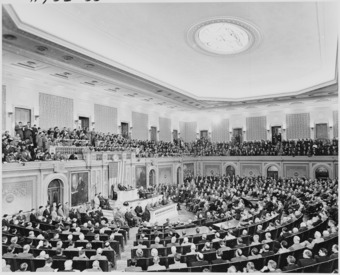
President Truman, 1950
President Truman delivers his State of the Union to Congress in 1950.
However, the State of the Union also contains heavy pathos that is intended to make citizens feel confident about the President’s handling of the nation and hopeful about the future. The President will spin data and use emotional appeals to make his or her case to the American people. This specific speech makes it clear that a speech can combine the features of informative and persuasive speeches.
1.5.4: Speeches for Special Occasions
Some special occasions require speeches that are different than speeches aimed at informing or persuading audiences.
Learning Objective
Differentiate a special occasion speech from an informative or persuasive speech
Key Points
- Special occasion speeches tend to be shorter speeches, commonly less than ten minutes.
- Special occasion speeches are commonly addressed to a particular audience.
- Depending on the context, special occasion speeches can be funny or sad.
Key Terms
- context
-
the situation in which something happens.
- pathos
-
an appeal to an audience’s emotions or sensibilities.
- toast
-
to engage in a salutation and/or accompanying raising of glasses while drinking alcohol (or other appropriate beverage) in honor of someone or something.
As the name implies, special occasion speeches are speeches that are given on special occasions. There are many examples of special occasions where it might be appropriate to deliver a speech. For example, an individual might give a speech at a wake or memorial for an audience of friends and families who knew the person being memorialized. Clearly this speech will be very different than a toast given at a wedding, which is also an example of a special occasion speech and which will have a much more celebratory tone. A commencement ceremony or award ceremony are some other special occasions during which someone may give a speech.
Special occasion speeches are usually shorter than informative or persuasive speeches. Special occasion speeches are usually less than ten minutes long, which demonstrates that their purpose is different than other types of speeches delivered at a conference or political rally. Depending on the context, the purpose of a special occasion speech may be to remember, to praise or to humorously tease. They may contain a use of pathos that aims to convince the audience to be happy, possibly by being comedic. However, they may use a pathos intended to make the audience reflective, as in a speech given at a memorial service.
Special occasion speeches might inform the audience. For example, someone may give a speech at a wedding and share a specific memory, thus informing the audience of that particular incident and possibly articulating its importance in relation to the newlyweds. While special occasion speeches may be informative, their purpose is always specific to the context and audience that will be hearing them.

A wedding toast
The toasts that are given at a wedding are an example of special occasion speeches.
